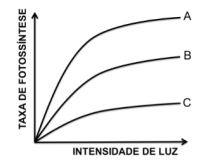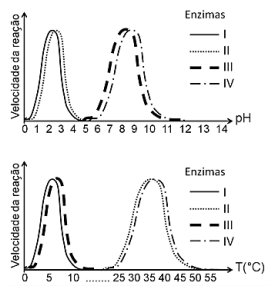Questões de Concurso Militar PM-PR 2014 para Bombeiro Militar
Foram encontradas 80 questões


Leishmaniose na mira: famosos se unem em campanha contra a eutanásia canina
Uma campanha realizada em conjunto com as ONGs paulistanas Arca Brasil e Ampara Animal tem como objetivo mudar as políticas públicas que dizem respeito à leishmaniose em animais. As indicações atuais são de que todos os cães afetados sejam eutanasiados, muitas vezes sem contar com a chance de tentar um tratamento.
Revista Veja São Paulo. http://vejasp.abril.com.br/blogs/bichos/2013/08/leishmaniose-eutanasia-campanha-famosos/. 27 ago.2013.
A razão do sacrifício dos cães é que esses animais oferecem riscos à população, pois apresentam o parasita
A partir dessas informações, responda: Qual é a probabilidade de um filhote do casal formado pelos animais 13 e 16 nascer com narcolepsia?



Assinale a alternativa que associa corretamente cada condição à respectiva curva.
As enzimas provenientes do intestino de peixe e do estômago de ave da Antártida são, respectivamente.

Assinale a alternativa que apresenta os dois compartimentos celulares nos quais o pesquisador encontrará ácidos nucleicos radioativos.
Traduzido e adaptado de: PRESTON, D. & JOHNSON, P. Ecological Consequences of Parasitism. Nature Education Knowledge 3(10):47, 2010.
A respeito da inserção dos parasitas nas teias alimentares, considere as seguintes afirmativas:
1. Parasitas podem regular o tamanho da população de hospedeiros. 2. Parasitas podem atuar como presas. 3. Parasitas podem alterar o desfecho de interações competitivas interespecíficas.
Assinale a alternativa correta.


1. Type O blood people must eat a lot of meat and avoid milk, yogurt and cheese, for example. 2. Type O blood appeared before the other blood types. 3. Type B diet, which is rich in yogurt, milk, cheese and meat, can cause diabetes. 4. People who want to slow the ageing process or fight cancer and diabetes should follow the blood type diet. 5. Type A blood people should eat many vegetables because this blood type is related to agriculture.
Which of the statements above are TRUE, according to Peter D’Adamo’s ideas?